Physical Address
304 North Cardinal St.
Dorchester Center, MA 02124
Physical Address
304 North Cardinal St.
Dorchester Center, MA 02124

Tackle clutter in your historic home with 24 thoughtful bedroom storage solutions. Learn to blend authentic preservation with modern functionality from an expert.
Picture this: You’re standing in the upstairs bedroom of that charming 1890s Victorian you fell in love with. The light streaming through the wavy glass is perfect, the original fir floors have that beautiful, warm glow, but the closet… well, it was designed for someone who owned three outfits and a hat. Now, your modern life is spilling out everywhere, and that serene sanctuary feels more like a storage locker. It’s the classic conflict: a historic home’s soul versus a modern person’s stuff.
Everyone thinks you just need to buy more bins or slap up some shelves. But in an old house, it’s not that simple. You’re not just organizing; you’re acting as a steward. It’s about working with the house’s original character, not fighting against it. You have to be a bit of a detective, an artist, and a strategist all at once. So, pour a cup of coffee. Let’s go through how you can reclaim your space without sacrificing the history you love.
Before you even think about buying a new piece of furniture or drilling a single hole, you have to get honest about your space and your stuff. This is the unglamorous part, but I promise you, getting this right saves you so much time, money, and heartache down the road. It’s the architectural equivalent of “measure twice, cut once.”
You know everyone preaches this, and it sounds so tedious. But in an old house, this isn’t just about ‘sparking joy.’ It’s about practicality and respect. Most historic homes were built with a fraction of the storage we expect today. You simply don’t have the luxury of keeping things “just in case.” Being ruthless isn’t a personality flaw here; it’s a design requirement. This first pass forces you to decide what truly deserves a place within these historic walls.
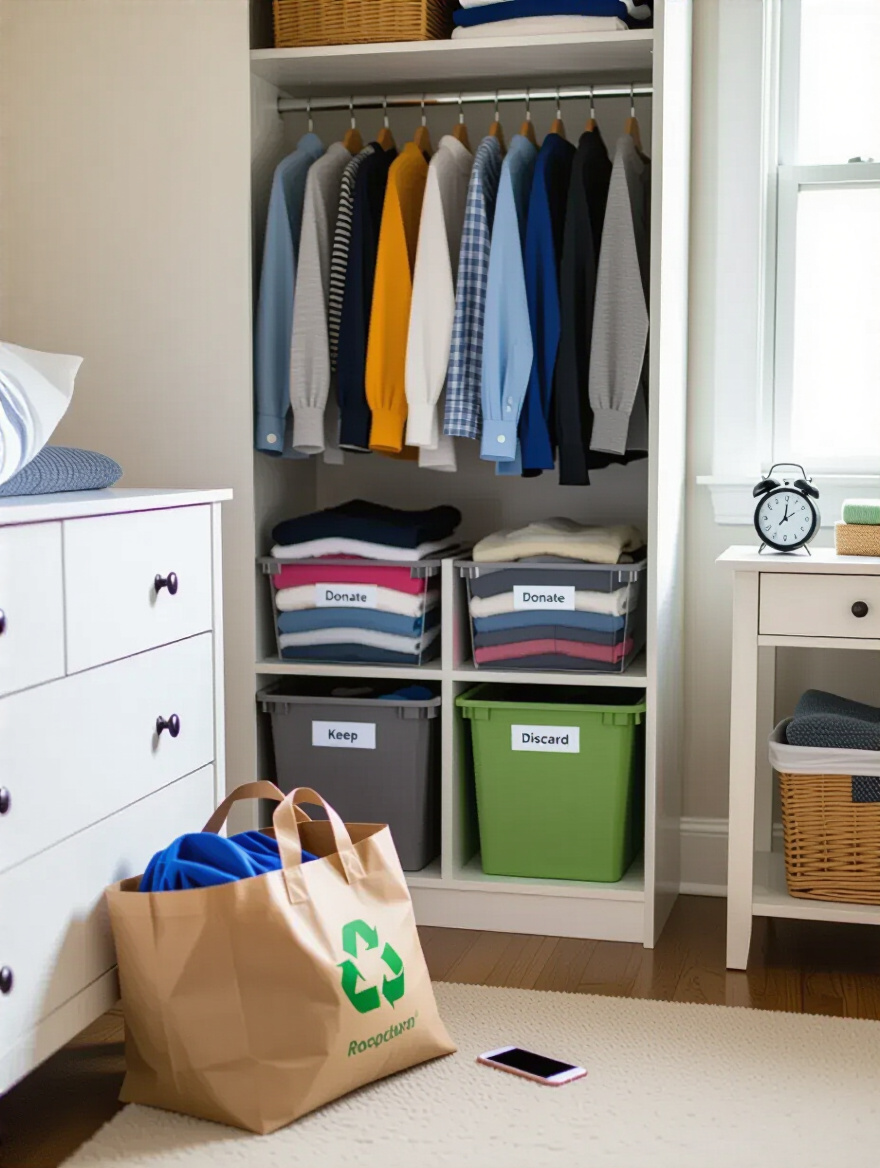
I had a client once in a gorgeous Queen Anne, and she was emotionally attached to everything. We couldn’t even walk through her bedroom. I finally asked her, “Does holding onto three broken lamps and a box of old college textbooks honor the history of this house, or does it disrespect the space by turning it into a warehouse?” That reframing was all she needed. She realized her job was to let the room breathe. Don’t fall into the “maybe someday” trap—in an old house, “someday” never comes because there’s nowhere for it to live.
Now that you’re left with only the things you truly value, you can figure out exactly how much space you have to work with—and in an old home, that’s never what you think it is.
I cannot stress this enough: old houses are not square. Your walls lean, your floors slope, and that perfectly rectangular alcove is probably an inch narrower at the back than it is at the front. I watched a client lose a small fortune on a custom-built wardrobe because he only measured the opening at the floor. When the installers arrived, the unit wouldn’t fit because the wall bowed out an inch and a half in the middle. He had to pay for them to take it back, resize it, and reinstall it weeks later.

Get a good steel tape measure and measure everything—width, depth, and height—at multiple points. Top, middle, and bottom. Front and back. Write it all down on a sketch of the room. Note where the light switches are, how the door swings, and the location of that old cast-iron radiator. This detailed map isn’t just data; it’s your blueprint for success. It tells you the truth about your space and prevents you from making expensive, frustrating mistakes.
With a clear inventory and a map of your house’s charmingly imperfect dimensions, you can start assigning things to their logical places.
This sounds like a no-brainer, but it’s the part people skip. We all have that one “junk drawer” that’s actually five different junk drawers, a junk closet, and a junk corner. The key is to create dedicated “zones.” All your socks go in one place. All your books on one set of shelves. All your winter sweaters in one specific spot. When you group things, you suddenly see the real volume you’re dealing with. It turns an abstract problem (“my clothes are everywhere”) into a concrete one (“I need a space that can hold twenty folded sweaters”).
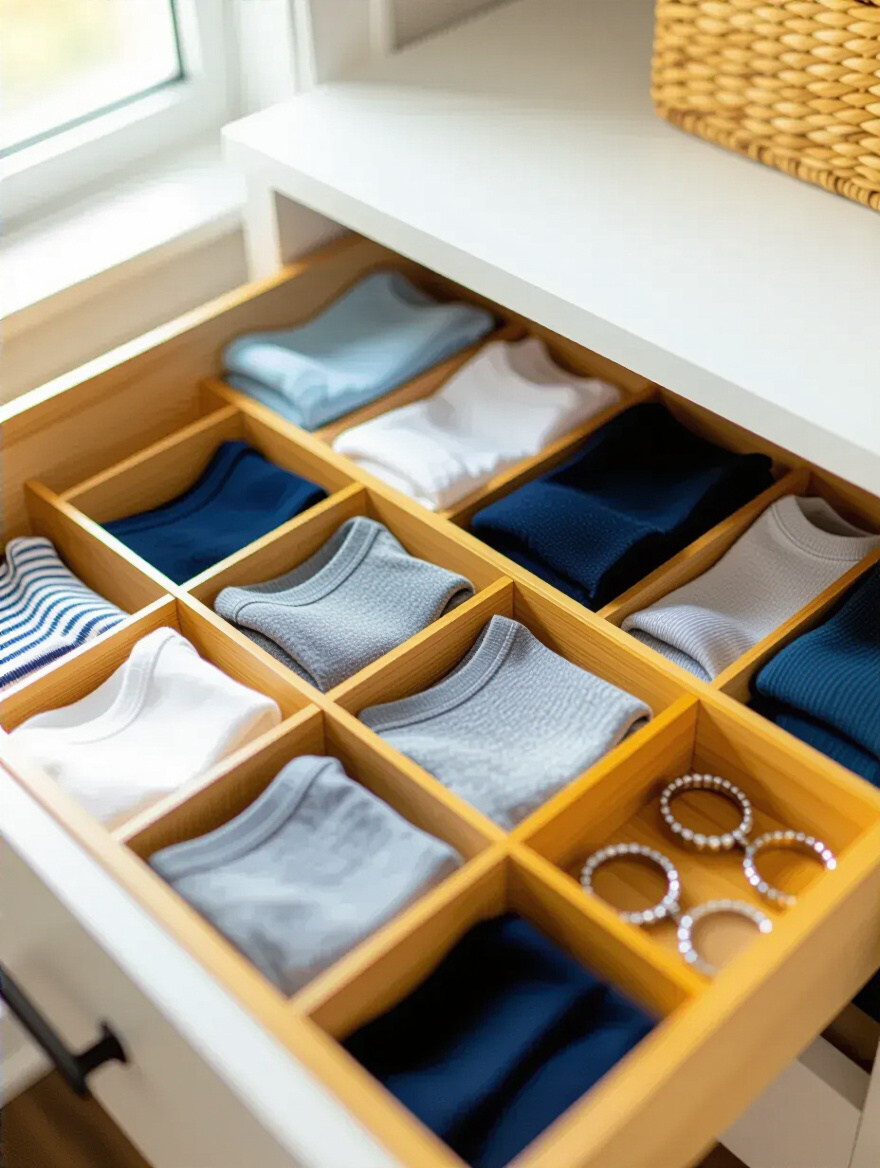
This is where the magic starts to happen. Instead of just trying to find an empty spot for something, you start thinking systemically. A client of mine had books piled on her nightstand, on the floor, on a chair… We gathered them all into one giant pile. Seeing them all together, she realized two things: first, she had enough to fill a dedicated bookcase, and second, she didn’t actually want to keep half of them. Grouping items gives you clarity, and clarity is the first step toward real, lasting organization.
You’re starting to see the potential. Now, let’s go on a treasure hunt for space you didn’t even know you had.
Old houses are full of strange, wonderful nooks that modern construction has eliminated. Do you have an unusually deep windowsill? That’s a bookshelf. An odd, shallow closet that seems useless? Perfect for shoes or accessories. What about the space above your door frames? That’s prime real estate for a high shelf to store things you only need once a season, like guest bedding or off-season hats.
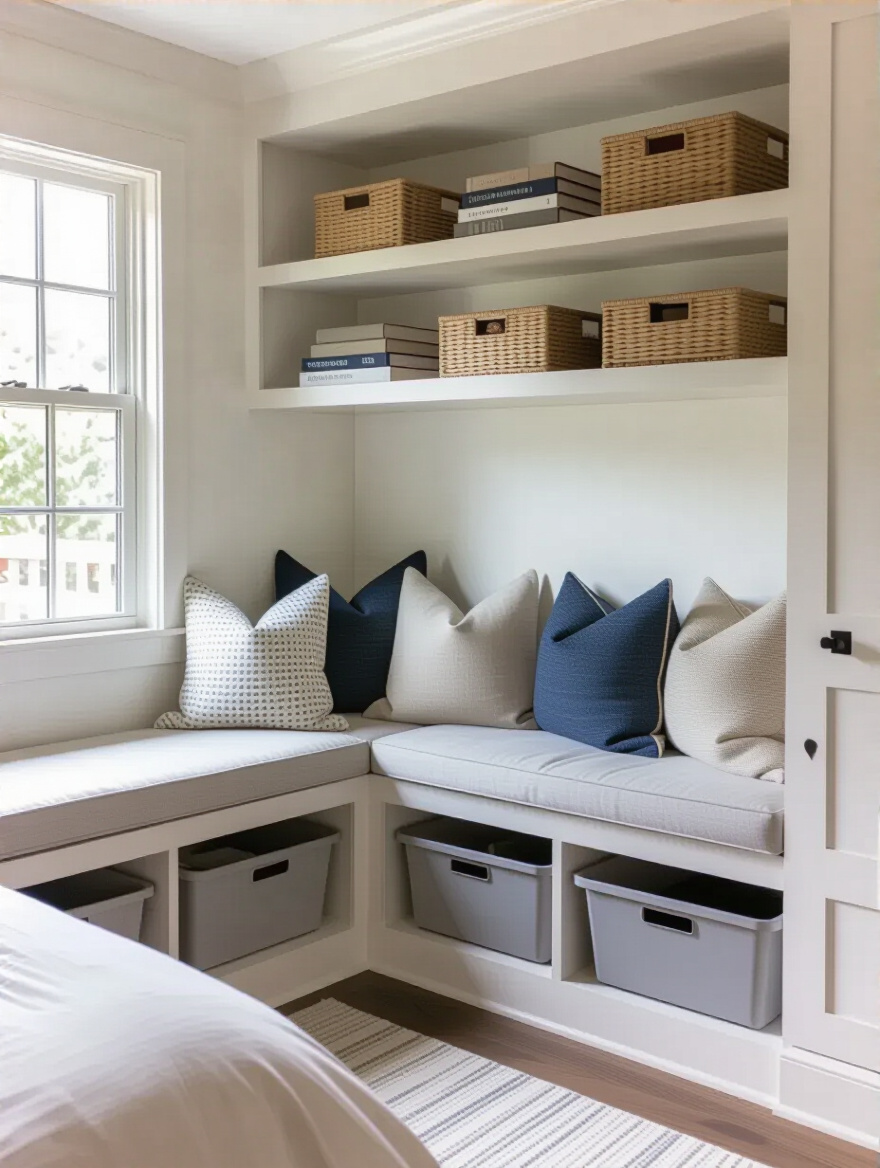
I call this “thinking in three dimensions.” Don’t just look at the floor plan; look up. Look down. Last year, working on a 1920s Tudor revival, we discovered a 10-inch-deep, 4-foot-wide space behind the plaster where a chimney flue had been removed decades ago. It was just dead space. With a little careful framing, we turned it into a stunning, recessed built-in bookcase that looked like it had been there forever. Your home has secrets like this. Your job is to find them and put them to work.
By now, a clearer picture of your needs and opportunities should be forming. It’s time to turn those observations into a concrete plan.
Okay, deep breath. Stop thinking about specific products for a minute and ask yourself a simple question: “What is the biggest problem I’m trying to solve?” Don’t say, “I need more storage.” That’s too vague. Get specific. Is it, “I can never find a matching pair of socks in the morning”? Is it, “My books are getting damaged from being piled on the floor”? Or is it, “I need a place for my laptop so it’s not on my bed all the time”?
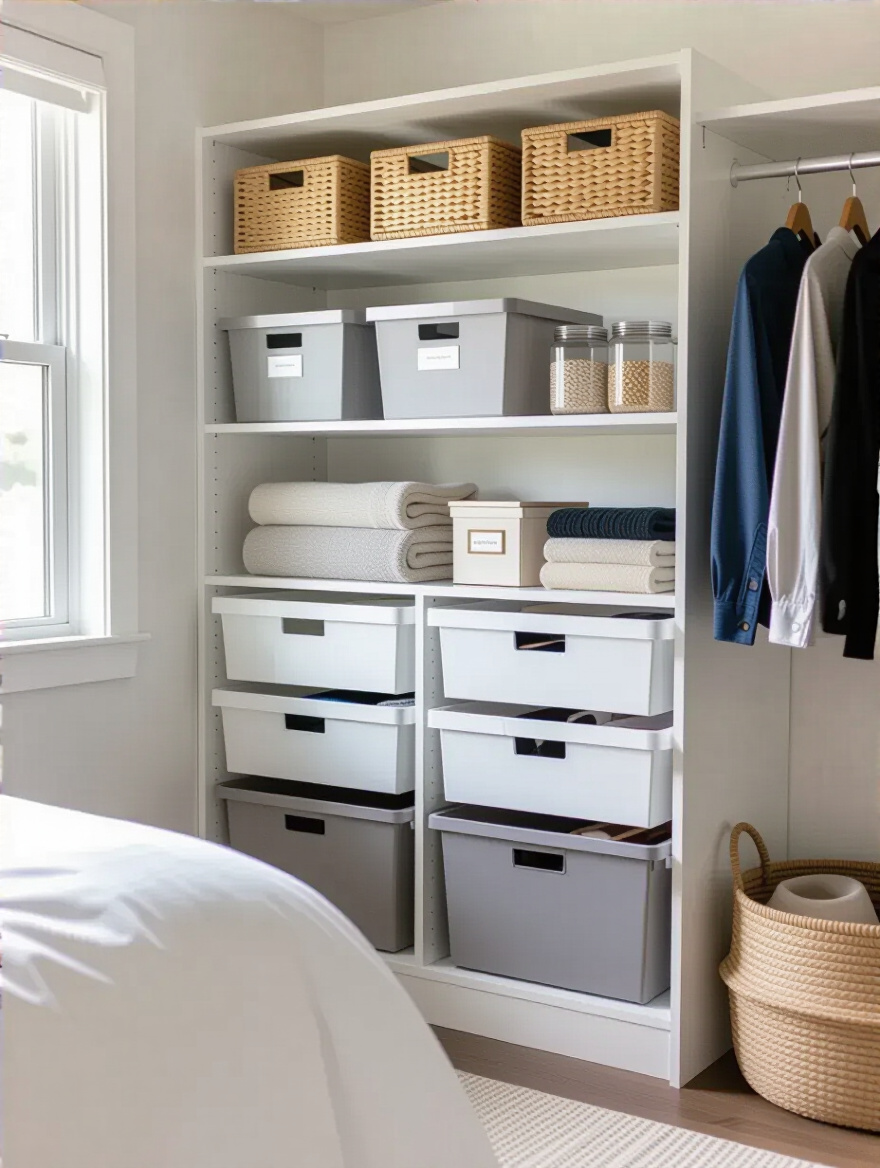
Each of those problems has a different solution. The sock problem needs drawer dividers. The book problem needs shelving. The laptop problem might need a small fold-down desk or a better nightstand. When you define the goal first, you stop buying generic solutions that don’t actually fix anything and start investing in targeted tools that solve your specific frustrations. This is the difference between buying clutter to store your clutter and actually creating a functional, peaceful system.
Now that you know exactly what each item’s purpose and final destination will be, you can create a system so foolproof it practically maintains itself.
This sounds incredibly nerdy, but it’s the secret to making organization last. Every single thing you decided to keep needs a permanent, designated home. Not just a general area, but a specific spot. The extra blankets don’t just go “in the closet”; they go in the wicker chest at the top of the closet. Your watch and keys don’t just go “on the dresser”; they go in the antique ceramic bowl on the left side of the dresser.
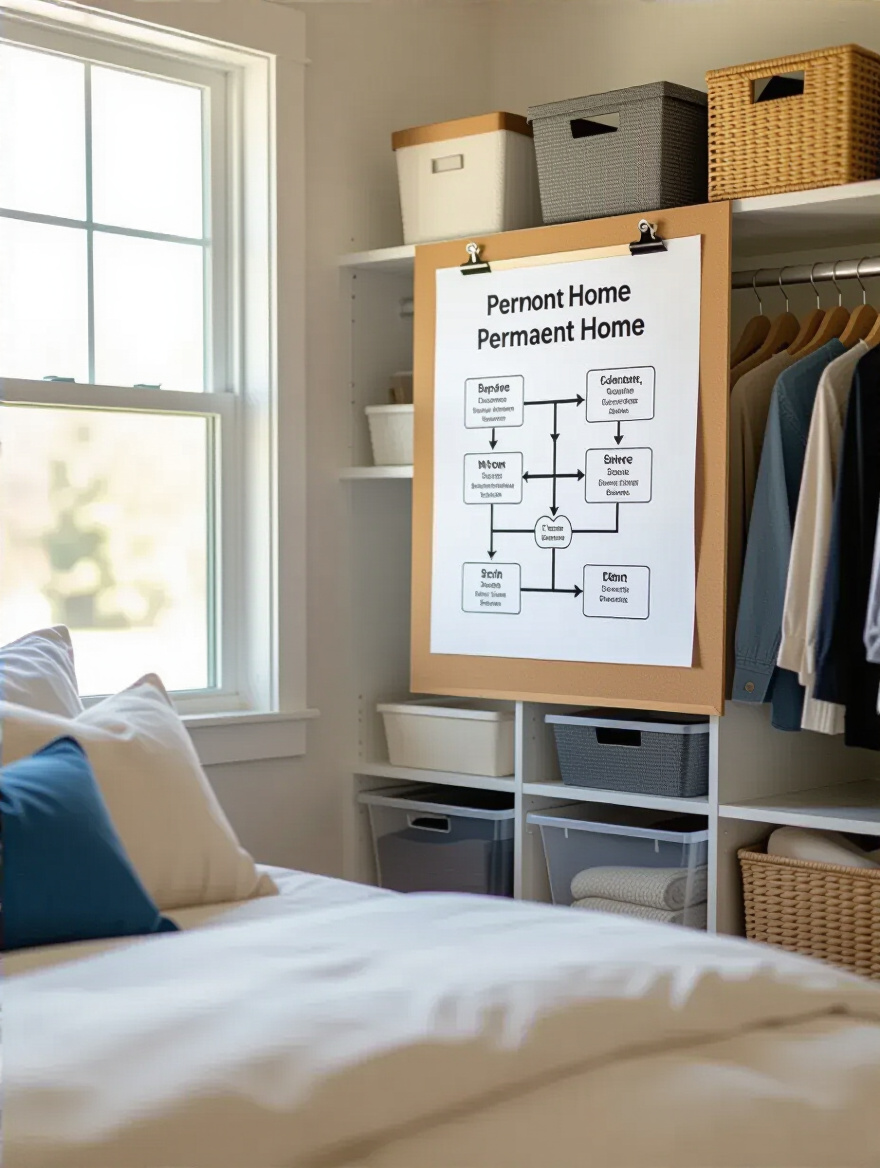
Think of it as creating a “return path” for everything. When you take off your sweater, you know its journey is straight to the third drawer down. When you come home and empty your pockets, everything has an immediate destination. This eliminates decision fatigue. You’re no longer standing in the middle of your room wondering where to put something. You already know. This single habit is what separates a temporarily tidy room from a permanently organized one. It’s the difference between a constant battle and effortless peace.
Now for the fun part. With your plan in hand, you can start choosing pieces that work for you, not against you. In a historic home, every piece of furniture should earn its keep. You don’t have room for one-trick ponies. We’re looking for handsome, hard-working pieces that solve storage problems without looking like they came from a big-box store.
The space under your bed is a gold mine, especially if your home lacks deep closets. But don’t just shove stuff under there! That’s how things get dusty, forgotten, and destroyed by carpet beetles. The solution is proper containment. Low-profile wheeled drawers or lidded boxes are perfect for this. They protect your belongings and make everything easily accessible. No more fishing around in the dark for that one box of old photos.
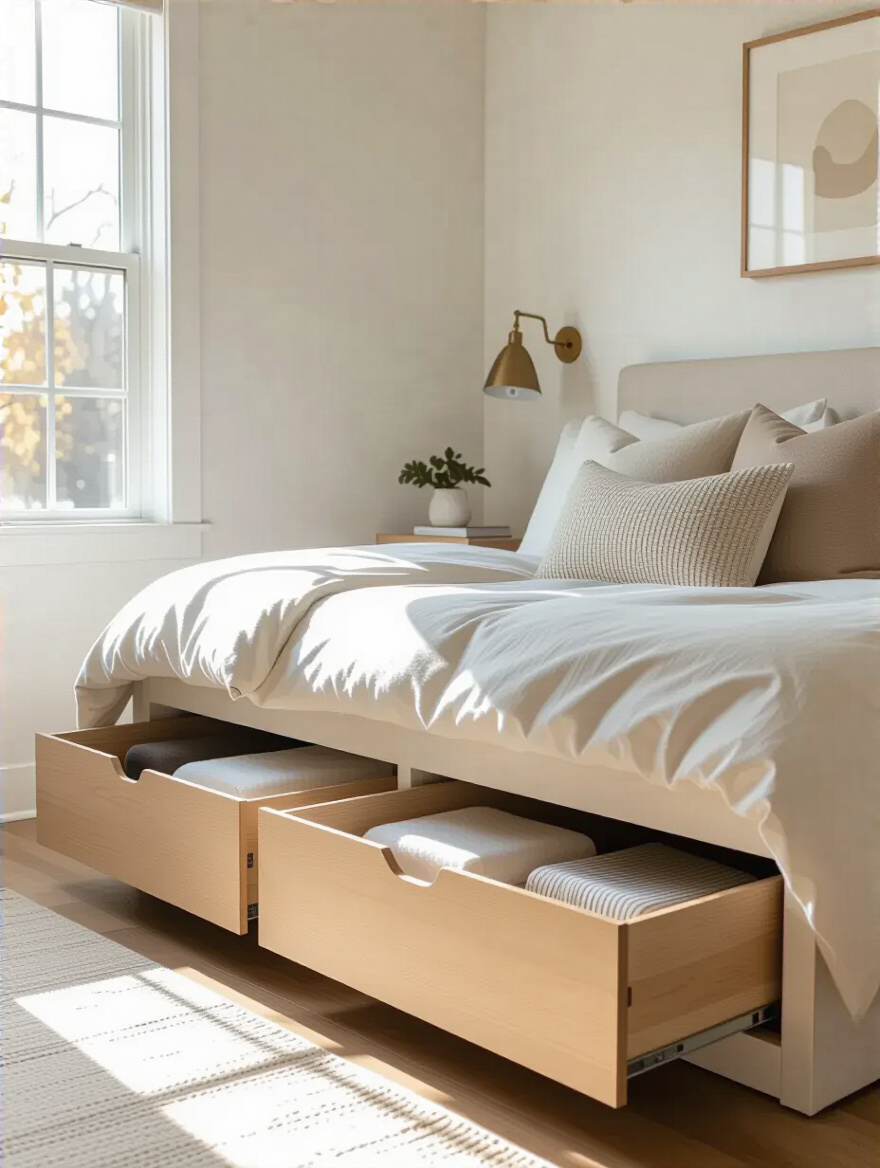
A great shortcut here is to use wooden drawers or beautiful fabric-lined boxes that feel in keeping with the quality of your home. You can even find antique under-bed drawers, sometimes called “trundle drawers,” at flea markets. These are fantastic for storing bulky, off-season items like wool blankets or winter coats, freeing up that precious little closet of yours for the clothes you actually wear every day.
By reclaiming the space under your bed, you’ve basically added a hidden dresser to your room. Why not make the bed itself do even more work?
This is the modern evolution of the captain’s bed, and it’s a brilliant solution for storage-starved old homes. A bed with built-in drawers or a lift-up ottoman base essentially gives you an entire dresser’s worth of storage without taking up a single extra inch of floor space. For a room with a small footprint, this can be an absolute game-changer, allowing you to eliminate a bulky piece of furniture and instantly making the room feel larger.
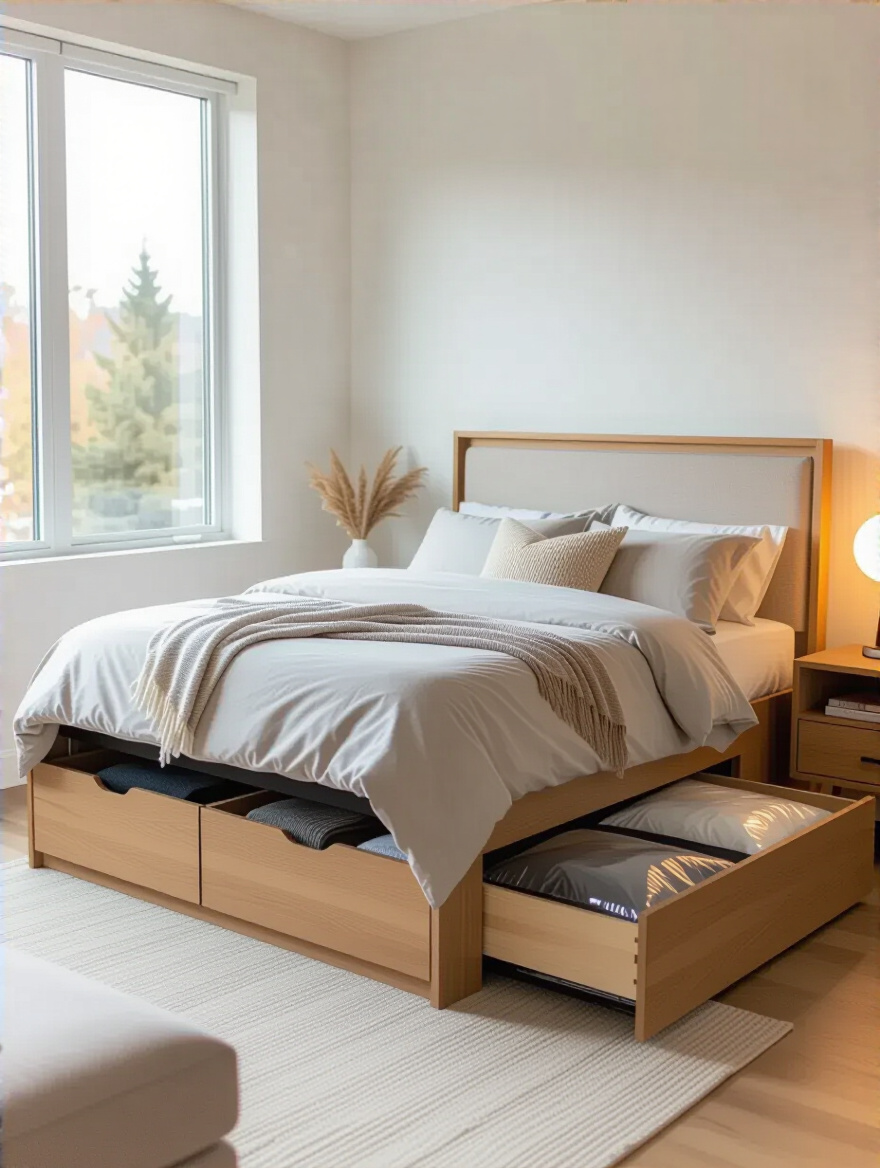
But here’s the pro tip for an old house: check your floors first. If your floors are significantly sloped, as they often are, pull-out drawers might not operate smoothly and can get jammed. An ottoman-lift style might be a better choice in this case, as it lifts straight up and isn’t affected by a non-level floor. It’s one of those little details that can save you a world of frustration.
Of course, your bed isn’t the only piece of furniture that can do double duty. Look for other opportunities to combine function with form.
Think like a ship’s carpenter, where every piece had to serve multiple purposes. Instead of a simple bench at the foot of your bed, find a beautiful storage bench or an antique blanket chest. This is the perfect place to sit and put on your shoes in the morning, and it can hold all your extra linens. Instead of a standard nightstand, consider a small secretary desk. It provides a surface for a lamp and a book, but you can also fold down the front to write a letter or use your laptop.
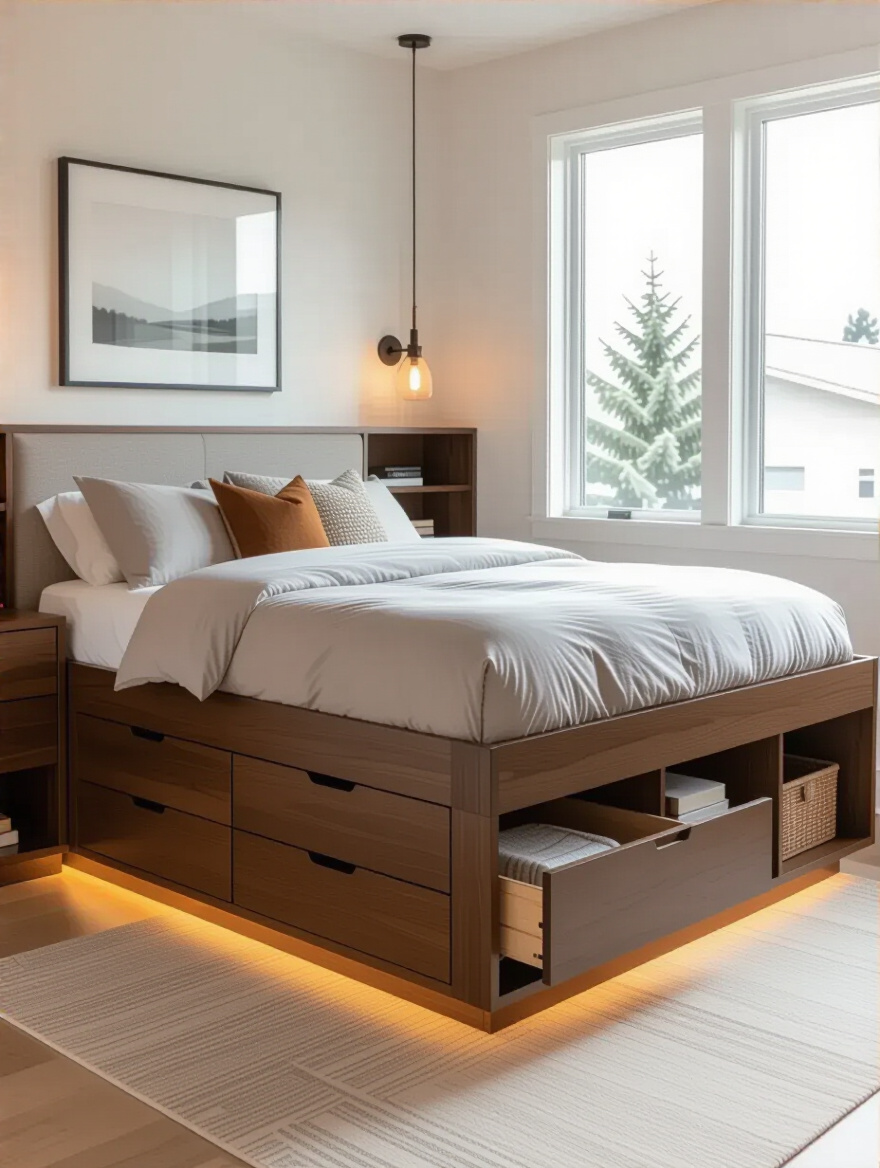
My favorite trick is using a tall, narrow armoire. In the days before closets were standard, these were the original solution. They provide a massive amount of vertical storage, from hanging space to shelving, all within a small footprint. Find a beautiful antique or a well-made modern one that complements your home’s style, and you’ve just solved a huge chunk of your storage problem with a single, elegant piece.
Even your room’s most basic architectural features, like doors, can be enlisted to help.
Now, a word of caution here. The cheap, ugly plastic shoe organizers are not your friends. They look terrible and can scream “temporary solution.” More importantly, the metal hooks on many over-the-door units can scratch the paint and dent the wood of your beautiful, solid old doors. Treat those doors with the respect they deserve.
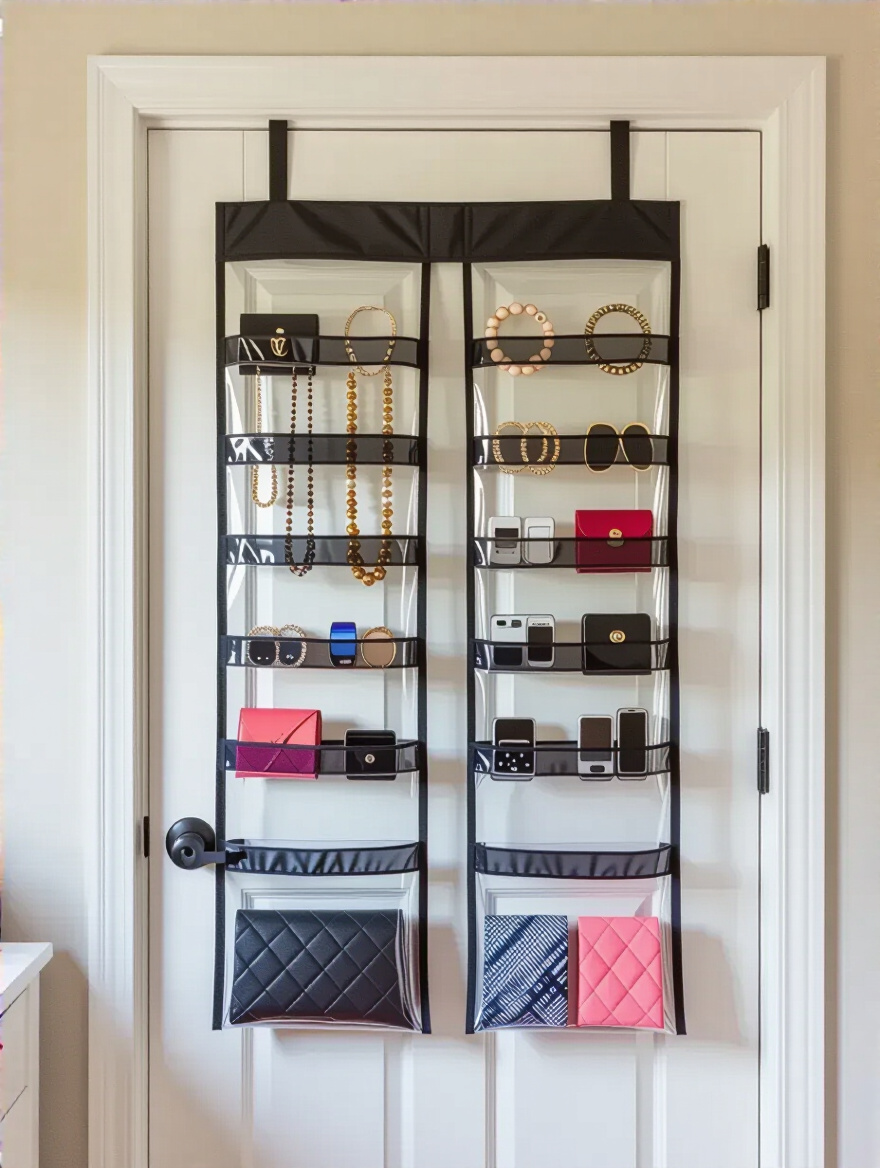
Instead, look for high-quality organizers made from canvas or natural fibers. For a truly elegant solution, you can mount a series of beautiful hooks or a shallow set of custom-built shelves directly onto the door. I once had a client install a series of antique brass hooks on the back of her closet door for her collection of scarves and necklaces. It turned a jumble of accessories into a beautiful, functional display and honored the period of the home.
As long as we’re looking at the bed area, let’s reconsider the one piece of furniture that’s often just a decorative afterthought.
A headboard doesn’t just have to be a pretty frame for your pillows. A storage headboard can completely eliminate the need for cluttered nightstands. Look for designs with built-in shelves or small cubbies. This is the perfect spot for your book, a glass of water, your phone, and your reading glasses. Everything is within arm’s reach but tucked away and out of sight, which instantly makes the whole room feel calmer.
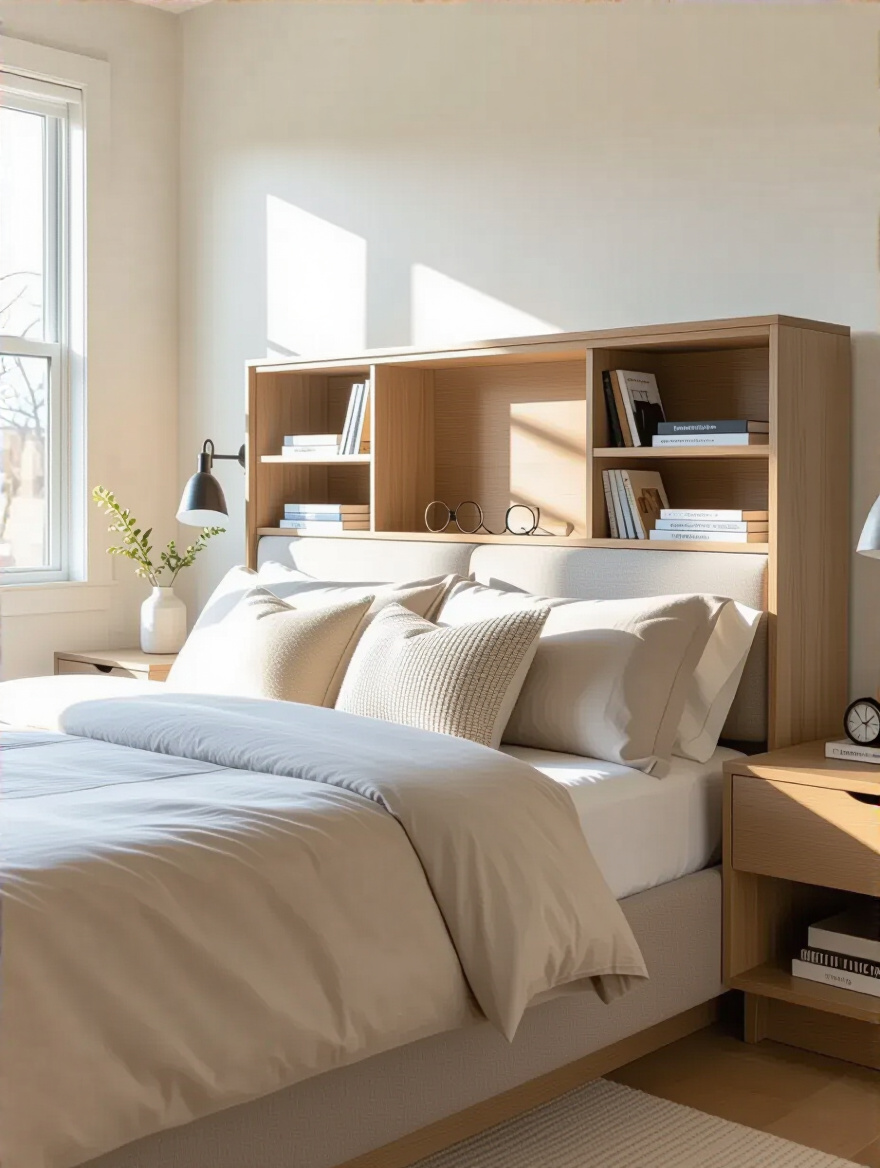
This is another area where you can think historically. Many classic designs, like Shaker or Arts and Crafts style furniture, often incorporated clever storage. A headboard with a simple, full-width shelf along the top is a nod to that tradition of practicality and clean lines. It can be a beautifully understated way to add function that feels completely in tune with your home’s heritage.
If you love your current headboard, you can still supercharge the storage right next to you.
The surface of a nightstand is a magnet for clutter. The solution? Get that clutter off the surface and into the nightstand itself. If you’re choosing a new one, skip the models with just one tiny drawer and an open shelf. That open shelf is just a fancy, four-legged clutter pile waiting to happen. Opt for a piece with multiple, deep drawers instead.
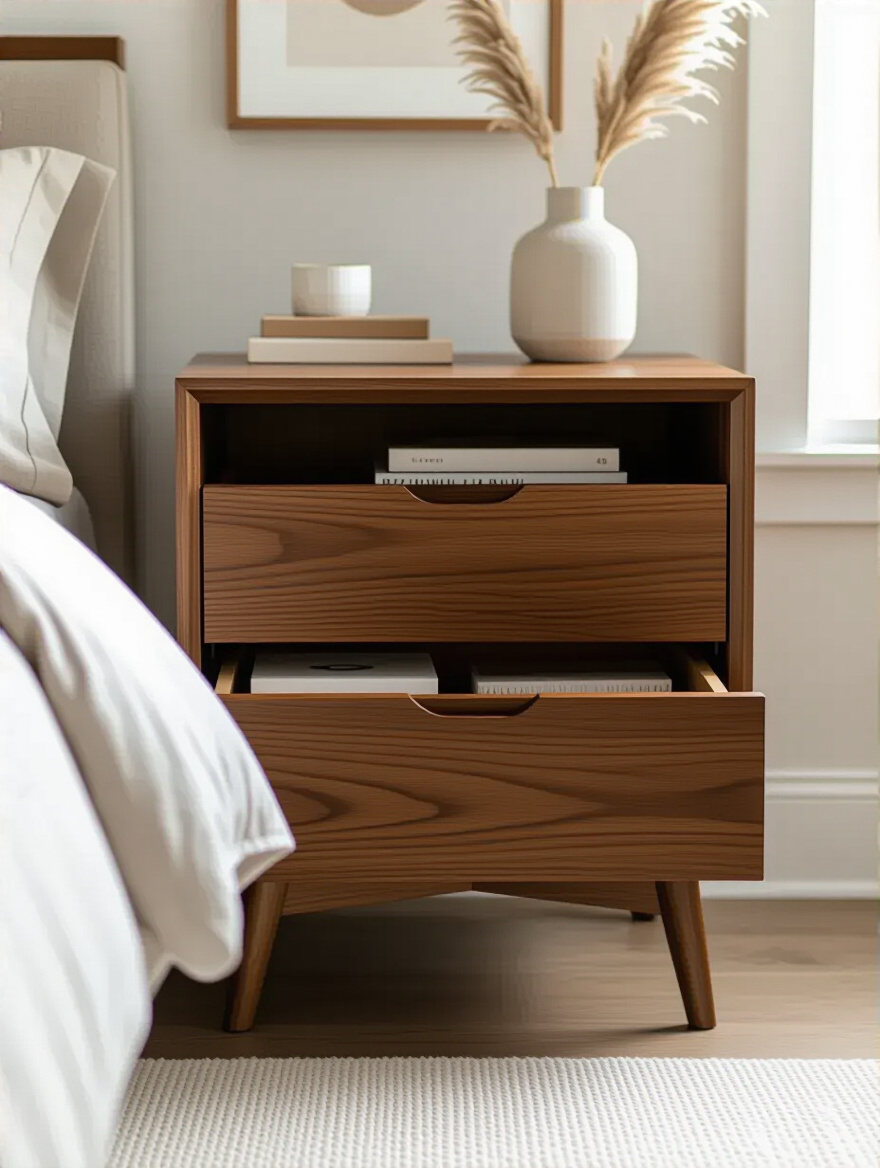
Look for vintage or antique chests that can double as nightstands. A small three-drawer dresser can offer a huge amount of storage and add so much more character than a flimsy modern table. This is where you can store not just your book and glasses, but also extra charging cables, lotions, and journals. A clear surface with just a lamp and a single decorative object creates an incredible sense of peace and order right where you need it most.
You’ve maximized your furniture, but in a historic home with a small footprint, you need to think beyond the floor. The walls are your next great frontier. By going vertical, you can dramatically increase your storage capacity without making the room feel crowded.
Hold on. Before you grab a drill and head to IKEA, we need to have a serious talk about your walls. If your house was built before the 1950s, you likely have plaster and lath walls, not drywall. This is a completely different animal. You can’t just use a standard drywall anchor; it won’t hold. And finding a stud behind lath can be a real adventure.
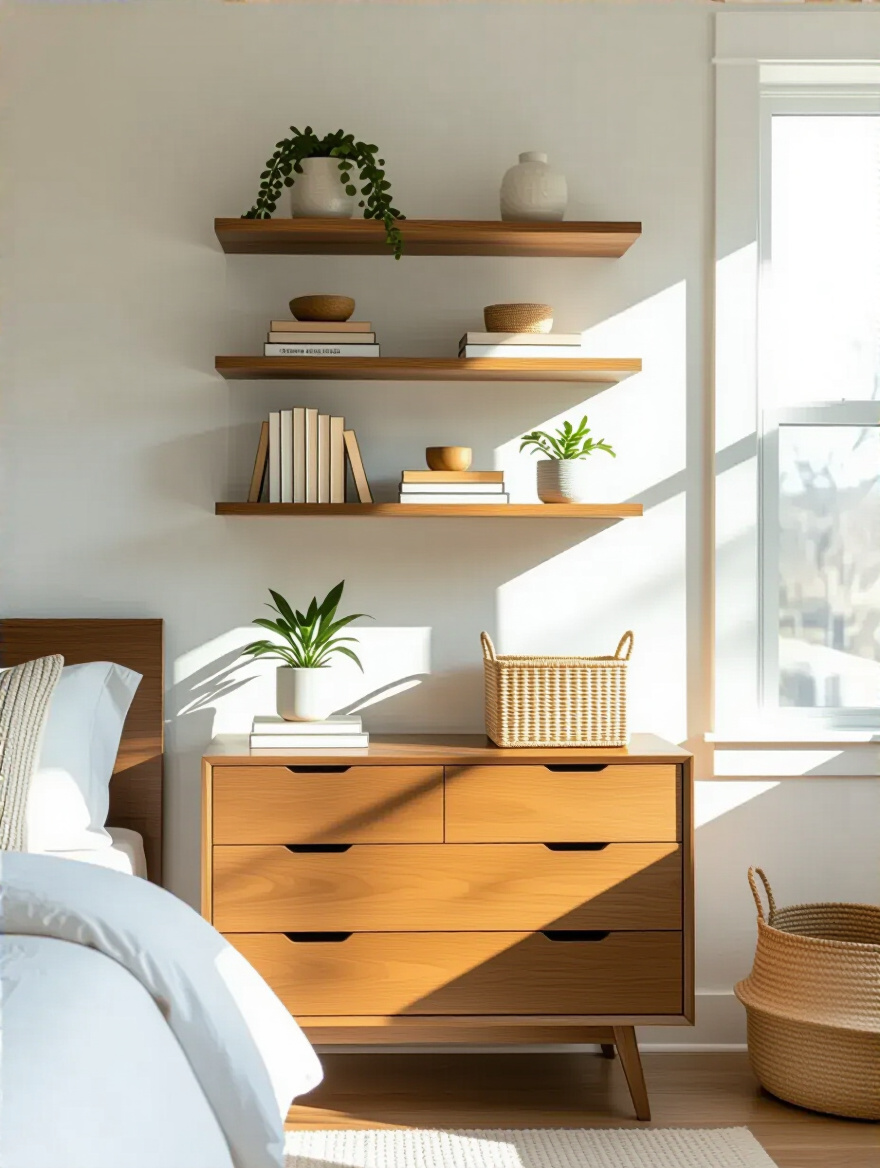
My shortcut? Use a good quality stud finder (a magnetic one often works best) and be patient. Or, even better, install shelves that are attached to a cleat system. A horizontal wooden cleat can be screwed securely into multiple studs, and then you can attach your shelf to that. For a really authentic look, use beautiful wooden brackets that match your home’s trim. Done thoughtfully, wall shelves can look like original built-ins and provide a perfect home for books and cherished objects.
Now let’s look at the trickiest spaces of all—the corners, which are almost never a perfect 90 degrees.
Corners are the Bermuda Triangle of most rooms—dead space where dust bunnies gather. But a slim, tall corner shelving unit can turn that useless nook into a powerhouse of storage. This is the ideal spot for things you don’t need every day but want to have accessible, like a small collection of records, a stack of photo albums, or decorative boxes holding craft supplies.
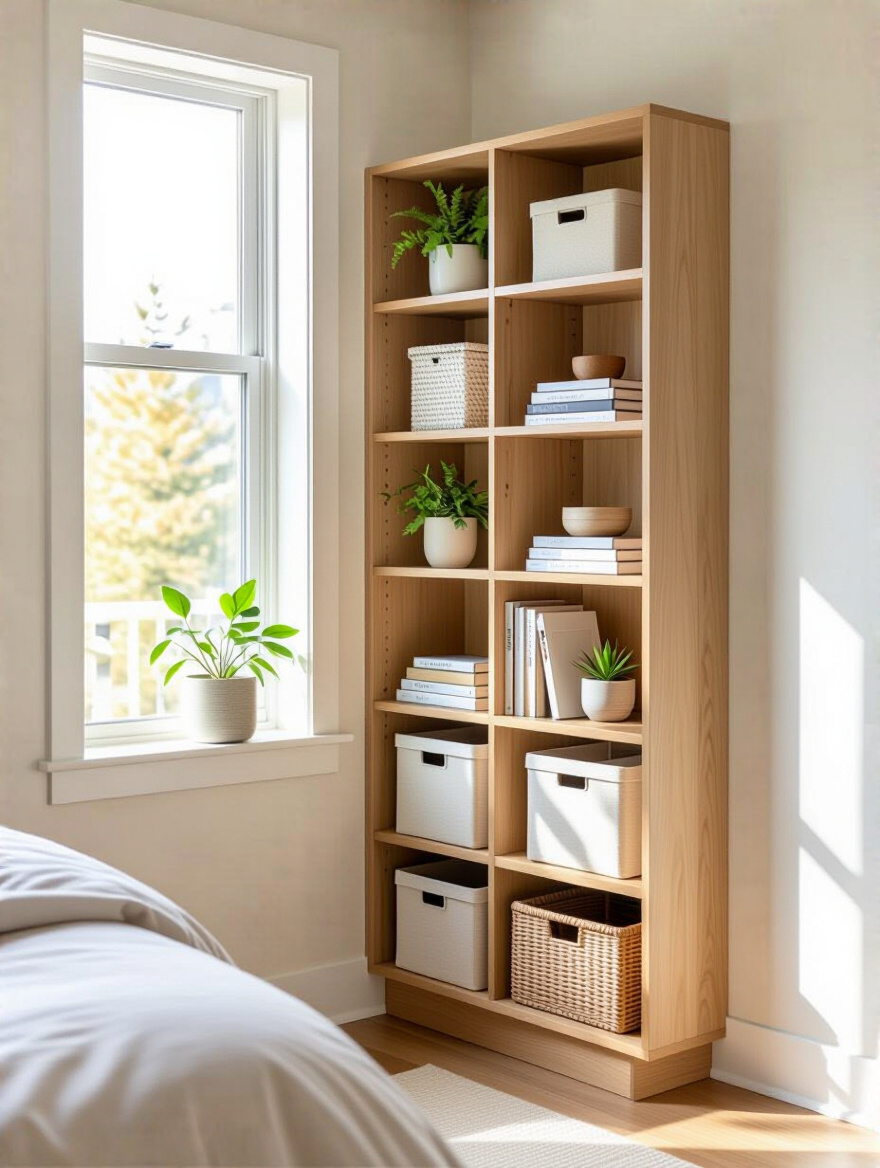
Because they tuck away so neatly, corner shelves don’t interrupt the flow of the room or make it feel smaller. In fact, by drawing the eye upwards, they can actually create the illusion of more height and space. Look for simple, classic designs in wood or metal that either blend in with your walls or complement the style of your other furniture.
Let’s now turn our attention back to that tiny closet and perform some real magic inside it.
This is one of the easiest and most impactful changes you can make. The standard closet in an old house has one lonely wooden rod and a high shelf. That’s it. Tiered hangers and cascading hooks are brilliant tools for instantly doubling or even tripling your hanging space. You can hang five pairs of pants in the space of one, or cascade an entire outfit (shirt, jacket, pants) from a single hook.
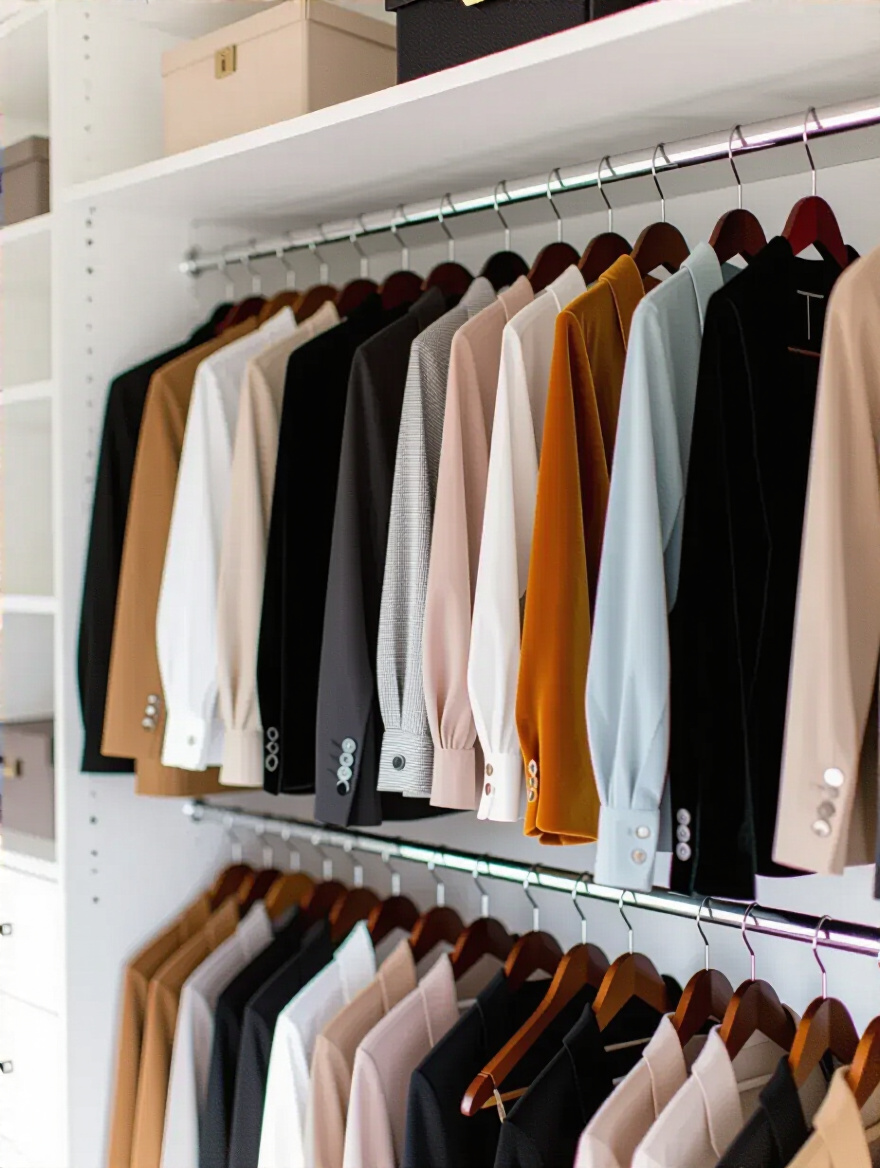
The absolute best investment you can make here are slim, velvet-covered hangers. Ditch the mismatched wire and plastic ones. The velvet hangers are thin, saving precious inches on the rod, and their non-slip surface means your clothes actually stay on them. Creating a uniform look with your hangers is a small detail that makes your closet feel instantly more organized and luxurious.
Now that your hanging clothes are in order, let’s address the stacks of folded clothes on that single shelf.
That high shelf in your closet is great, but stacking sweaters directly on it means you can never get to the one on the bottom without causing an avalanche. Stackable bins solve this problem beautifully. The key here is to get clear bins. It’s a simple rule: if you can’t see it, you won’t use it. Clear bins let you see exactly what’s inside at a glance, while still protecting everything from dust.
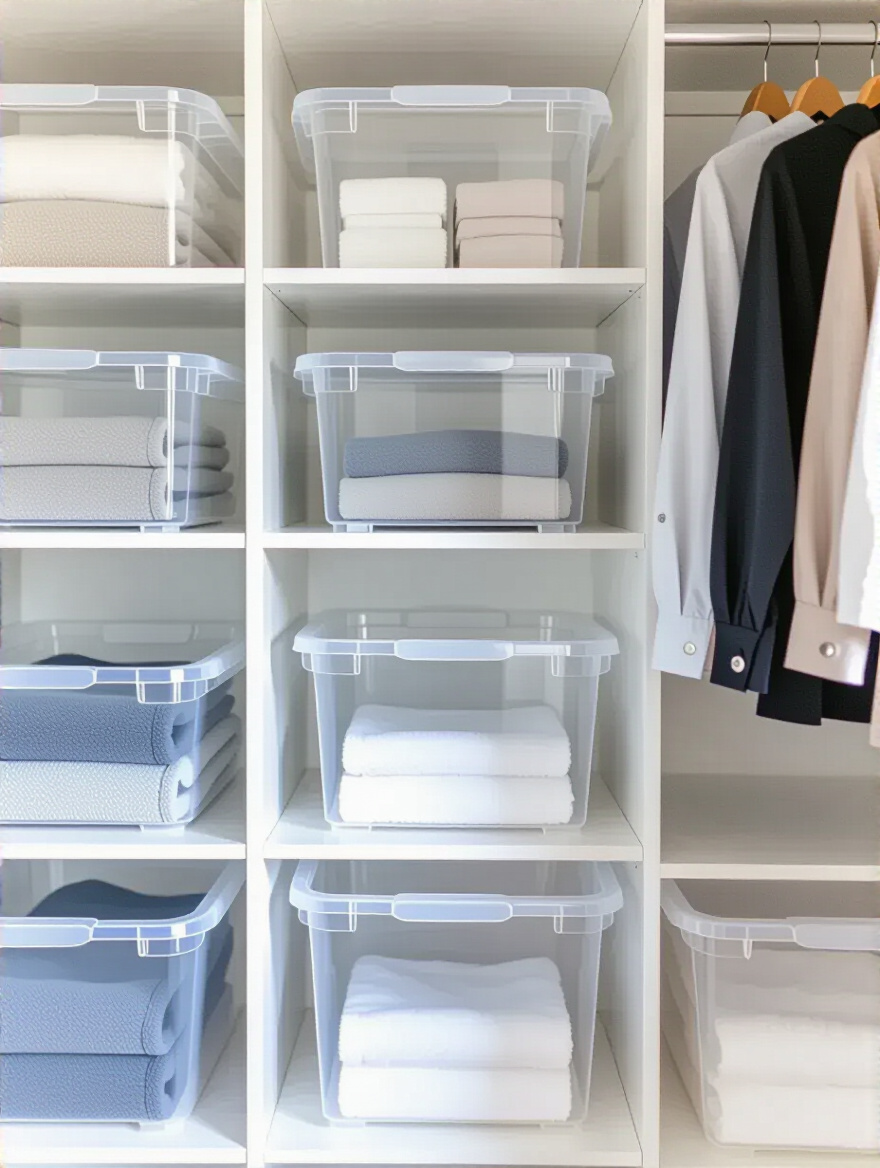
I recommend using these for bulky sweaters, extra t-shirts, or seasonal accessories like scarves and gloves. Label them, even if they’re clear. A simple label on the front (e.g., “Wool Sweaters”) removes all guesswork. This system turns that one deep, awkward shelf into a modular, highly-functional storage zone.
What if you need more than just storage? In today’s world, many bedrooms also have to function as offices.
A fold-down desk is a fantastic way to have a dedicated workspace that completely disappears when you’re done for the day. This is critical for maintaining your bedroom as a place of rest. But again, you have to respect your plaster walls. A heavy, cantilevered desk puts a lot of strain on its anchor points. This is a job that must be done right, anchored securely into studs.
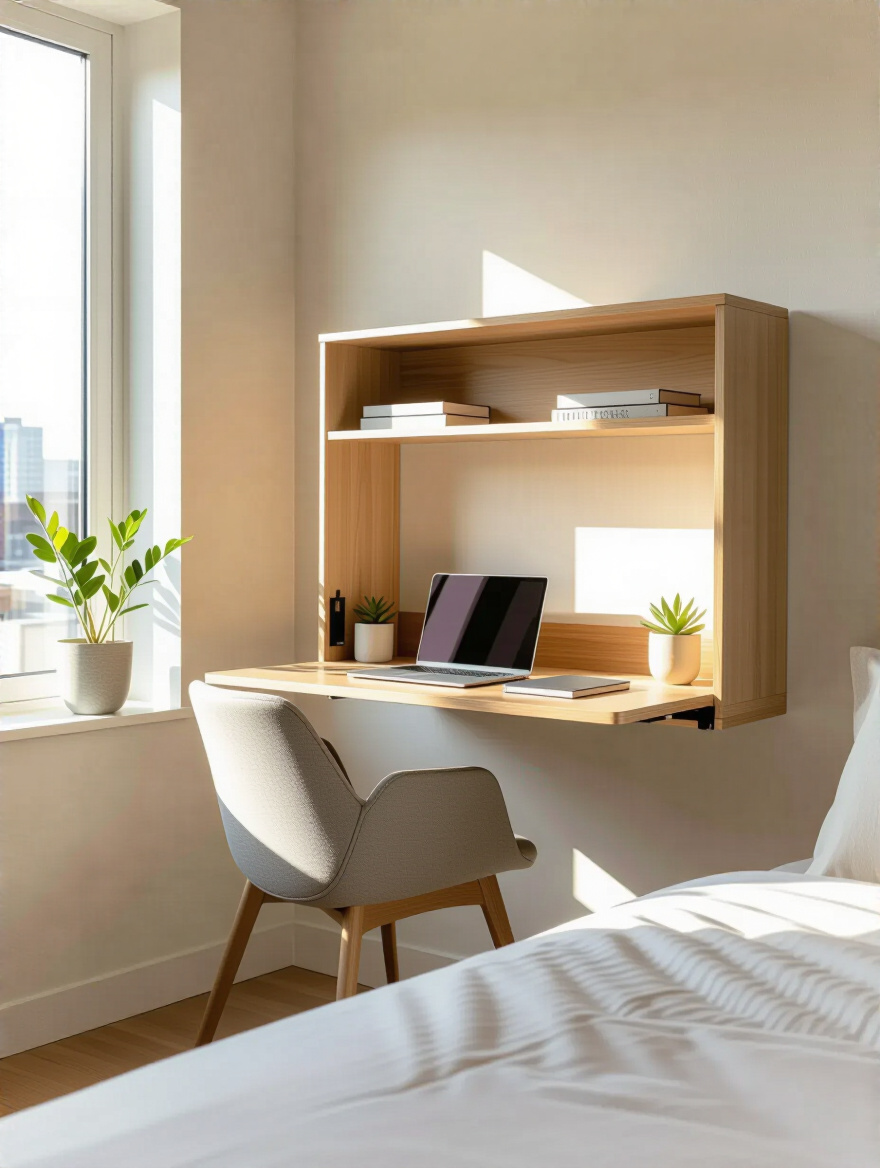
An even better, and more historically sympathetic, option is a modern take on the classic secretary desk. These are freestanding pieces that don’t need to be attached to your precious walls. They offer a fold-down work surface and a collection of drawers and cubbies for storage, and you can find them in styles from traditional to mid-century modern that will look right at home.
The big picture is coming together. Now, let’s get into the nitty-gritty details that make the whole system sing.
This is that KonMari method you’ve heard about, and I’ll admit, it’s brilliant. Instead of stacking your t-shirts and socks flat, you fold them into neat little rectangles and file them vertically in your drawers, like files in a filing cabinet. The difference is astounding. You can see everything you own at a single glance—no more digging for that one specific grey t-shirt.

Not only does this method save a surprising amount of space, but it also respects your clothing. Items aren’t being crushed under the weight of the stack, so they stay less wrinkled. It takes a little practice to get the fold right, but once you do, it makes getting dressed and putting laundry away surprisingly satisfying.
To take this one step further, you need something to keep your little folded packets from falling over.
You can have the most beautiful armoire and the cleverest shelves, but if you don’t have systems for the small stuff, clutter will creep back in. This final stage is all about maintenance and micro-organization—the small habits that keep your historic sanctuary serene for the long haul.
This is the secret weapon for taming your sock and underwear drawer, your nightstand drawer, or any drawer full of small, jumbled items. Adjustable dividers allow you to create custom-sized compartments for everything. Suddenly, your socks, ties, belts, and charging cables each have their own tidy corral. Nothing slides around or gets tangled up.
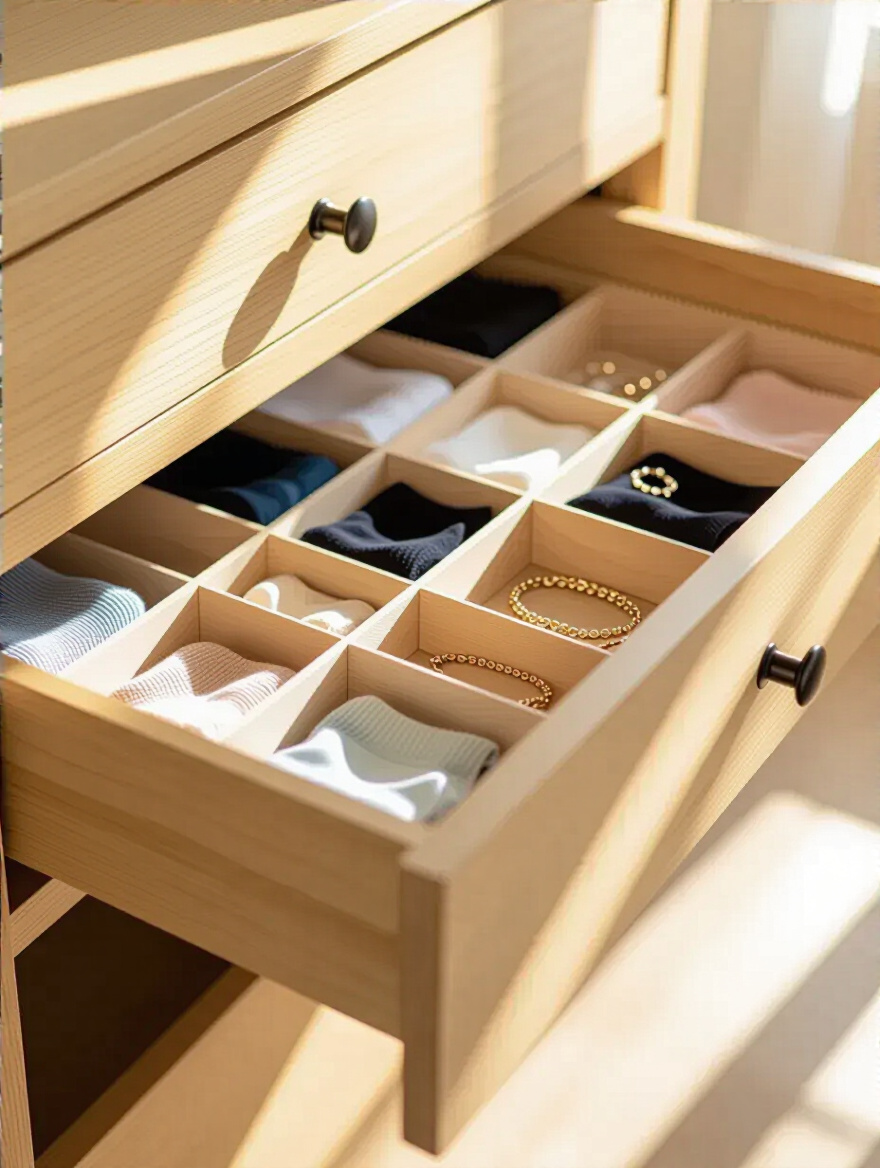
Forget the flimsy plastic ones. Invest in some beautiful bamboo or wood dividers. They look and feel like they belong in a quality piece of furniture, and they are sturdy enough to last a lifetime. This is a small upgrade that provides an incredible amount of daily satisfaction. Opening a perfectly organized drawer first thing in the morning sets a calm, in-control tone for the rest of your day.
With your hidden spaces under control, you need a strategy for the things that live out in the open.
For items that you need to access regularly, or for things stored on open shelves, beautiful baskets are your best friend. A set of matching wicker or canvas bins on a bookcase shelf can hold everything from magazines to craft supplies to electronics, all while looking cohesive and intentional. They hide the visual chaos and replace it with a calming, uniform texture.
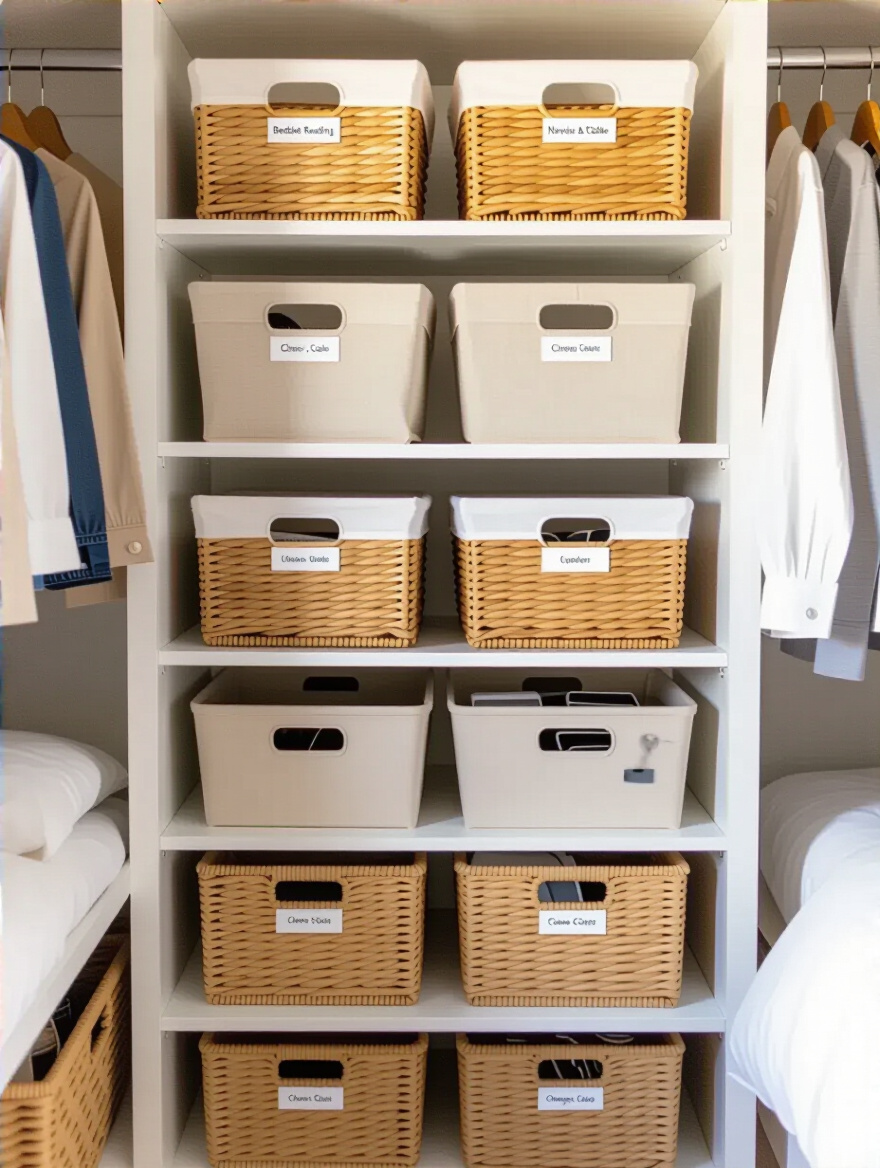
But here’s the non-negotiable part: you have to label them. It seems silly, but it’s crucial. A label turns a random basket of stuff into a system. You can use simple, elegant tie-on tags made of cardstock or leather, or even subtle chalkboard labels. Now, you and everyone else in your house knows that the bin on the left is for “Winter Hats & Gloves” and the one on the right is for “Pet Toys.” No more guessing.
Now let’s tackle the biggest source of daily clutter: the contents of your pockets.
Every day when you come into your bedroom, you need one designated spot to empty your pockets. This is your “landing strip.” It could be a beautiful ceramic tray on your dresser, an antique wooden bowl on your nightstand, or a small shelf by the door. This is where your keys, wallet, phone, watch, and loose change go. Every single time. Without fail.
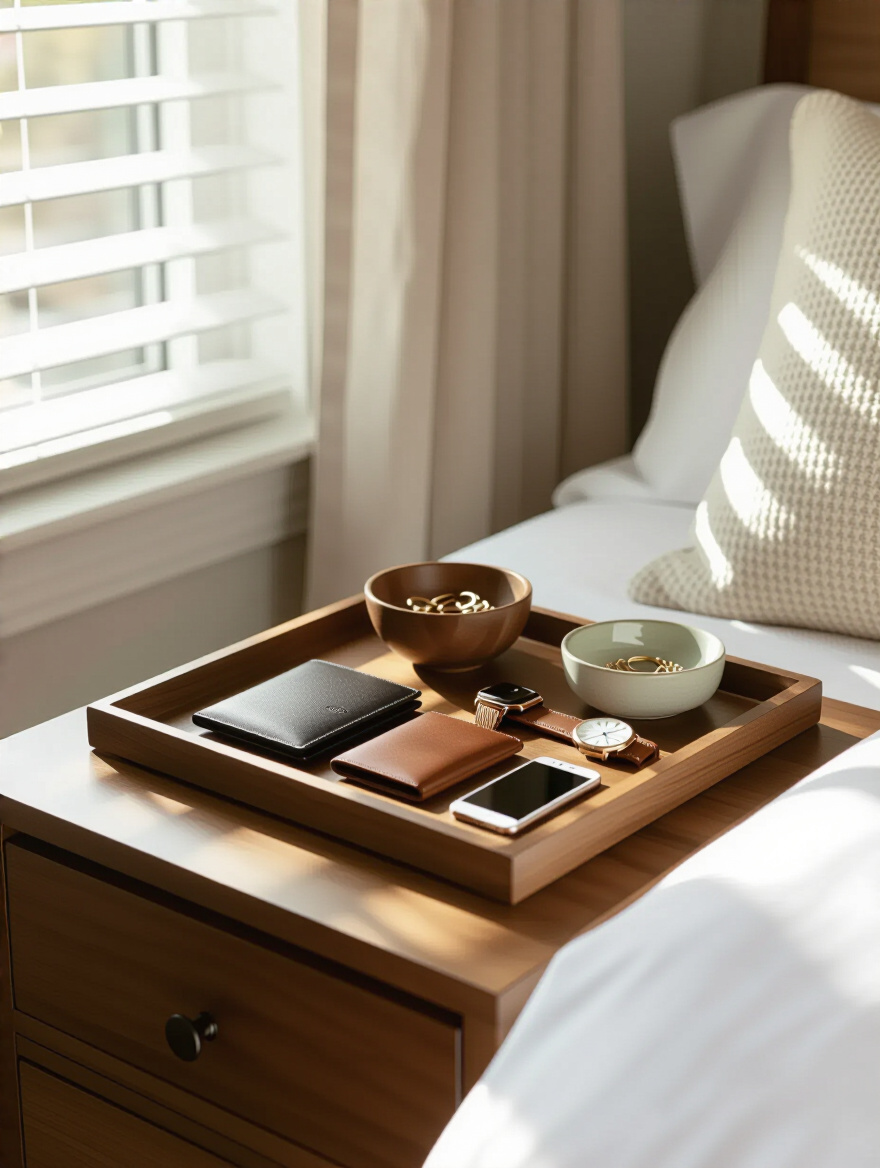
This one tiny habit completely eliminates that surface clutter that seems to appear out of nowhere. You’ll never waste another ten minutes frantically searching for your keys in the morning because they will always be on the landing strip. It’s a two-second action that buys you an incredible amount of peace of mind.
Once your daily habits are in place, you need to make sure your master plan is still working for you.
If you’re ready for a bigger project, a modular closet system can completely revolutionize a historic closet. Because old closets are often weirdly shaped—long and narrow, or with sloped ceilings—an off-the-shelf system from a big-box store rarely fits well. A truly modular system, like Elfa from The Container Store or PAX from IKEA, lets you design a solution that fits your closet’s exact, quirky dimensions and your specific wardrobe.
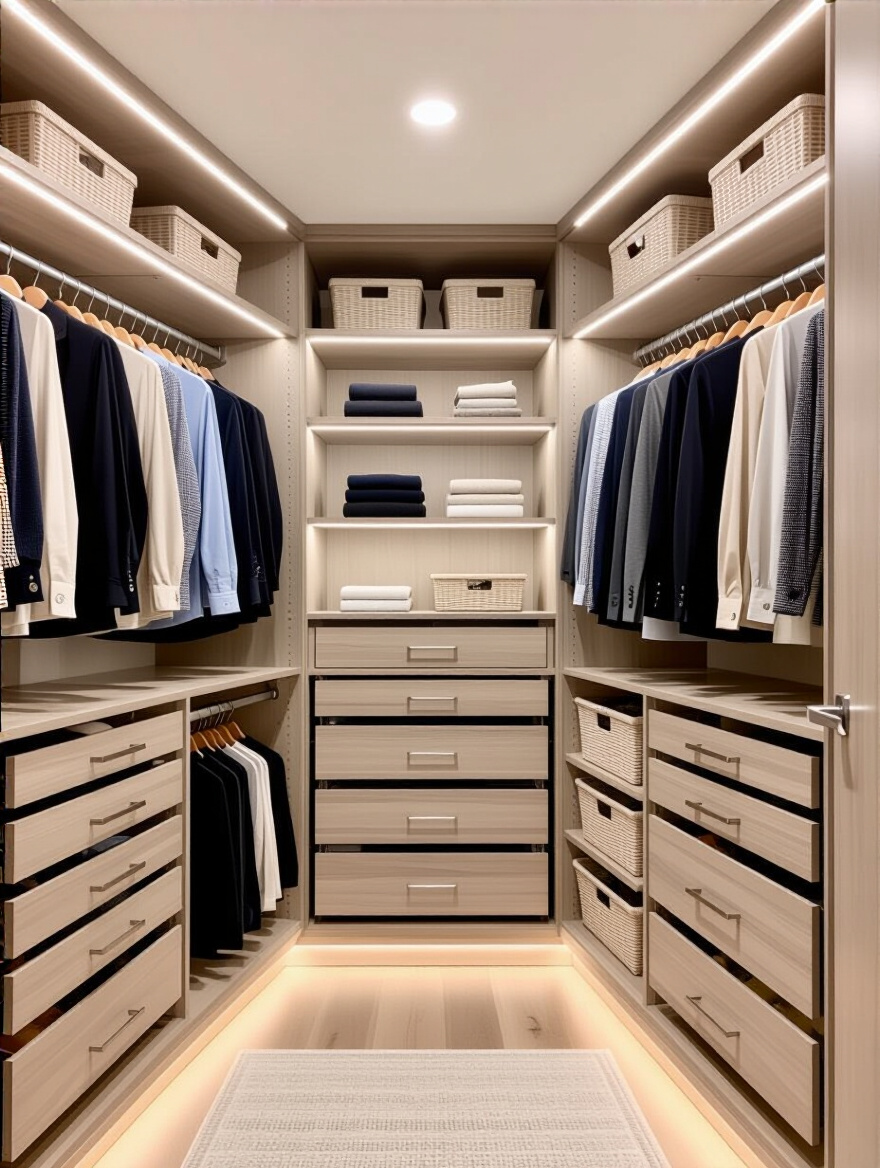
You can combine double-hanging rods for shirts and jackets, full-length hanging for dresses, pull-out drawers for sweaters, and angled shelves for shoes. You are literally building a custom closet inside your existing closet, maximizing every square inch of space. It’s an investment, but it’s one that pays you back every single day in time, efficiency, and a deep sense of satisfaction.
The key to it all, the one rule to rule them all, is next. And it’s the simplest one.
We’ve talked about this in bits and pieces, but it deserves to be its own rule. Clutter is nothing more than postponed decisions. When an item doesn’t have a designated home, you have to make a decision about where to put it every single time you use it. That’s exhausting. And when you’re tired, you just set it down on the nearest available surface.
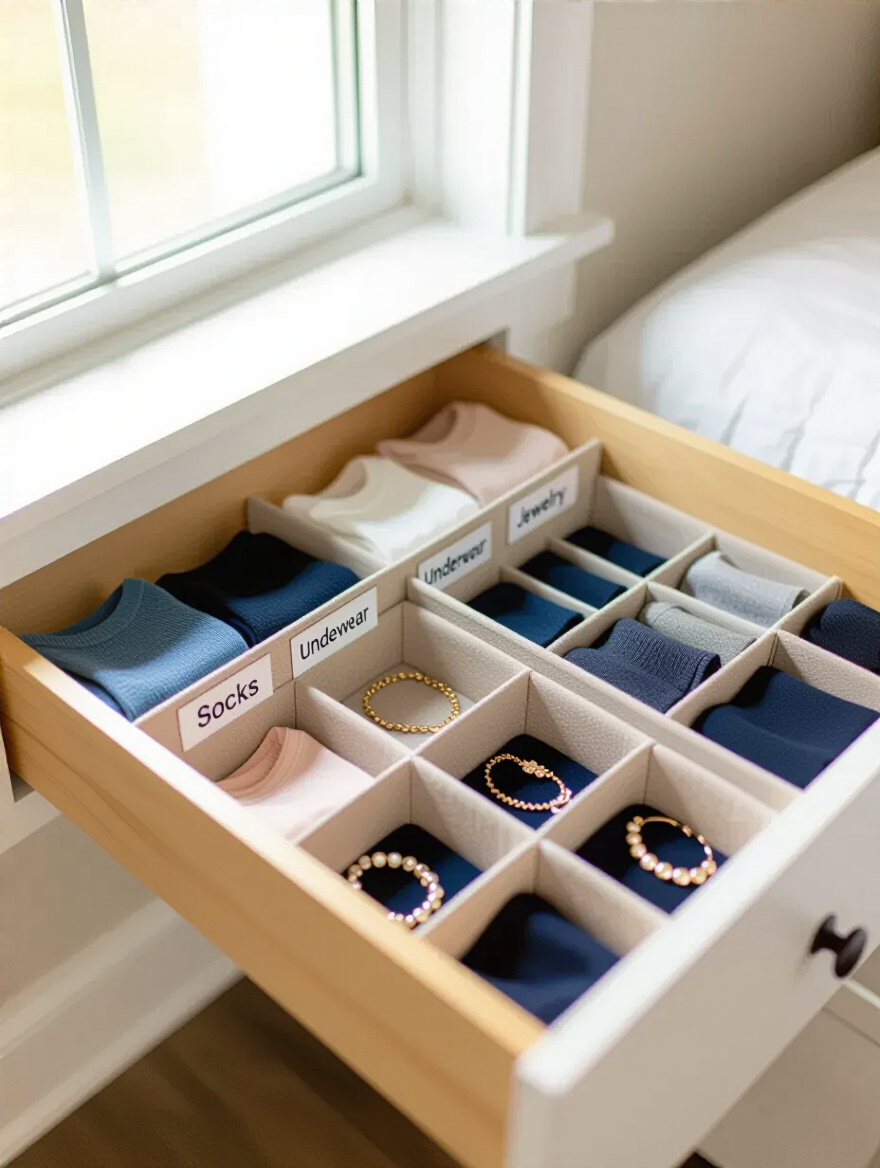
By giving every single item—from your winter coat to your nail clippers—a permanent home, you eliminate the need for those decisions. Tidying up is no longer a big, overwhelming project; it’s a simple series of two-minute actions. You just walk through the room and return everything to its home. It’s the most powerful principle of organization there is.
Finally, even the best systems need a tune-up now and then to keep them running smoothly.
Life changes. Your hobbies, your job, and your style all evolve. The perfect system you set up today might not be perfect in a year. That’s why you need to schedule a quick check-up for your bedroom twice a year. A good time is when you’re switching out your seasonal clothing in the spring and fall.
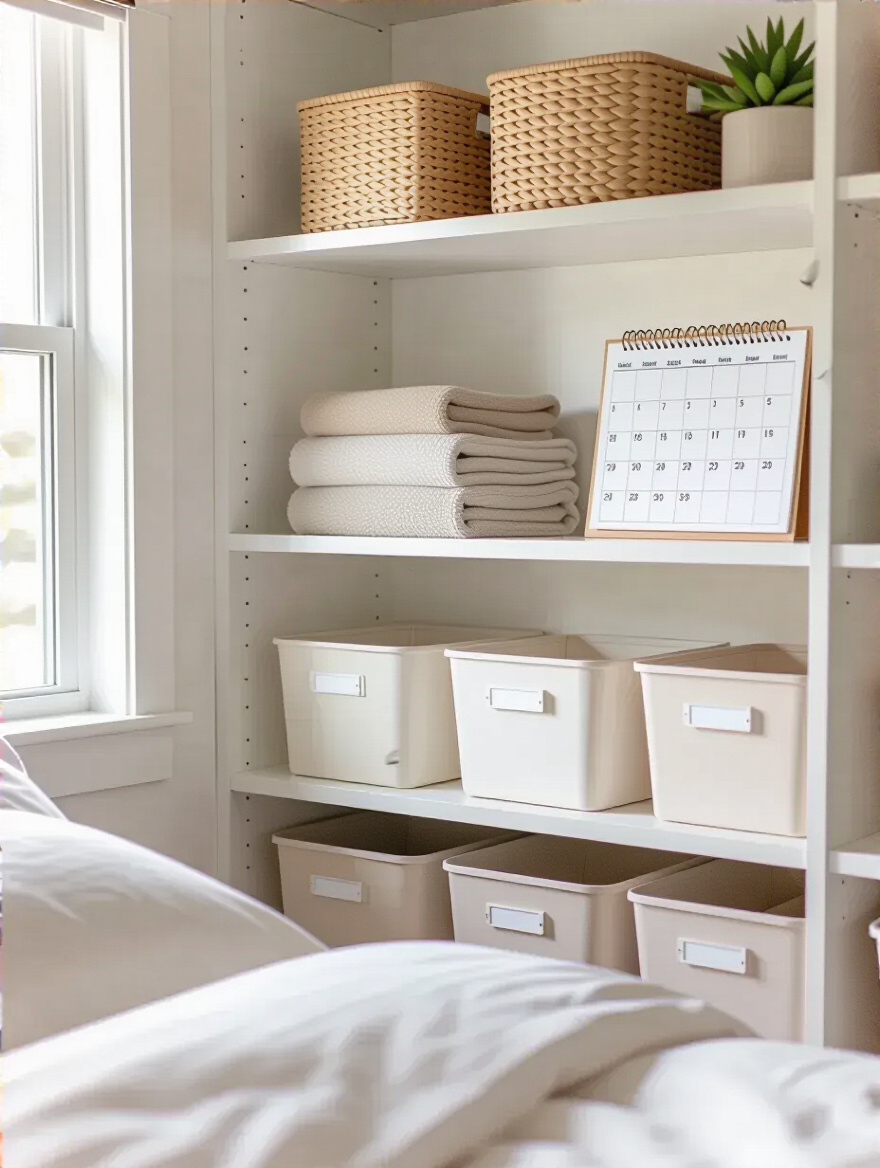
Take an hour or two to go through your closet and drawers. Be honest. Did you wear that sweater at all last winter? Do you still love that book? Are those shoes comfortable? This isn’t a massive, week-long purge. It’s just a little tune-up to weed out the things that no longer serve you. This regular maintenance ensures your storage systems stay efficient and prevents the slow, insidious return of clutter.
See? It’s not about fighting your house; it’s about entering into a partnership with it. Your historic home has its own story, its own logic, and its own beautiful imperfections. By understanding and respecting those, you can create storage solutions that are not only incredibly functional for your modern life but also feel like they truly belong. You’re not just tidying up your bedroom—you’re curating a space that honors the past while gracefully serving the present.
The calm and serenity that comes from a well-ordered space is a real, tangible thing. It’s the feeling of walking into your bedroom at the end of a long day and feeling your shoulders relax because everything is in its place. It’s the quiet satisfaction of knowing exactly where to find what you need, when you need it. Start with one drawer, one shelf, one small habit. You’re not just reclaiming your space; you’re preserving a piece of history and making it your own.